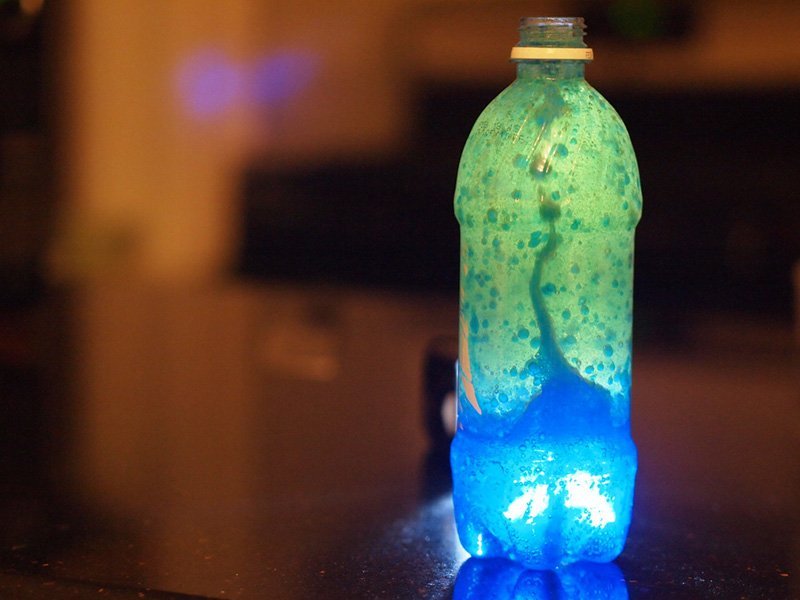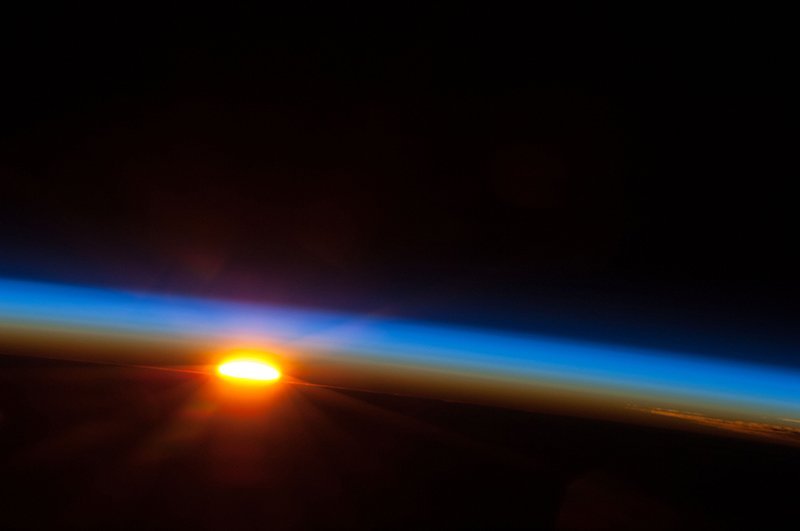Make a space lava lamp
Pages in this sectionUnderstand the behaviour of liquids in space
Liquids behave very differently on the International Space Station (ISS) compared to the way they behave on Earth.
On Earth, liquids take the shape of the container that holds them because of two forces: gravity and surface tension. The force of the surface tension is very small compared with gravity; gravity affects how liquids move and how objects and gases move through liquid.
In microgravity, the force of surface tension is the only force that affects how liquids behave. If the liquid is free of any surfaces, it will form a sphere, but as soon as it comes into contact with a surface, it will cling to it and spread across the surface.
We can get some idea of how liquids move in space by looking at how liquids of different thickness – or viscosity – move through each other. Viscosity is the term scientists use to describe how a liquid resists flow, so water is ‘thin’ and has low viscosity and vegetable oil is ‘thick’ and has a higher viscosity than water.
Ever-changing viscosity views in action
The different viscosities of water and oil make them ideal to show how differently liquids can behave in different conditions. Make a simple lava lamp to get some idea of what Tim Peake and other astronauts will see on the ISS, both with liquid behaviour and with the constantly changing views.
By making a simple lava lamp you can learn all about viscosity and enjoy endlessly changing constellations.
How to make a space lava lamp

What you need
- Clear plastic bottle with a lid
- Water
- Vegetable oil (check with an adult before your use all the cooking oil)
- Food colouring
- Indigestion tablets, such as Alka Seltzer
Special effects (optional)
- Glitter and/or sequins
- Torch
What to do
Fill the clear plastic bottle about a quarter full with water. Add a few drops of food colouring.
Then fill your container almost to the top with vegetable oil. Leave the bottle to stand still for a few minutes to allow the liquids to separate out. (Oil is not as dense as water, so it sits on top of the food colouring solution. When the mixture settles, there will be a clear line between the water and the oil.)
Break up the indigestion tablets and drop them – half a tablet at a time – into the bottle. (Be careful not to add too much in one go, as this could turn your beautiful lava lamp into a fizzy mess!)
Watch what happens.
Special effects
Experiment by adding a few drops of different colourings to see if you can achieve a sunrise effect. Maybe use yellow food colouring to start with and then gradually add red and then blue.
Add glitter and sequins along with the food colouring. The bubbles will move the glitter to create your own amazing constellations of stars and planets.
To get an even better effect, use a wide-based torch to shine up underneath your clear container and turn off all the other lights in the room.
How does it work?
When the indigestion tablets dissolve in water, bubbles of carbon dioxide (CO2) are made. As the bubbles of gas rise, they take some of the coloured water with them to the top of the oil. The gas in the bubbles escapes into the air and the coloured water sinks back down to the bottom. When all the gas bubbles have escaped, the liquids will settle into layers again. Just add more indigestion tablets to restart the process.
If you run out of tablets, screw the lid firmly on to the bottle and give it a good shake. Put it down on a flat surface and watch the oil and water separate out again in response to gravity.
Ever-changing views on the International Space Station
Just like your ever-changing lava lamp, while Tim Peake is on the ISS circling Earth at 28,800 km per hour, he can enjoy the sight of the sun rising and setting 15 or 16 times in 24 hours. So, about 90 minutes after the sun rises, it goes dark again!
There are no clouds in space, and the constellations of stars and planets are in constant motion, so the appearance and disappearance of the sun is constantly changing and fascinating to watch.
